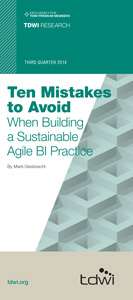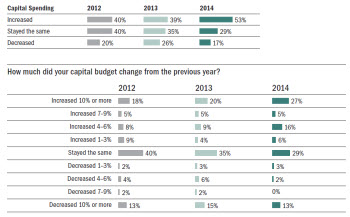 View online: tdwi.org/flashpoint
View online: tdwi.org/flashpoint





October 9, 2014
ANNOUNCEMENTS
NEW TDWI Best Practices Report
Real-Time Data, BI, and Analytics
NEW TDWI Checklist Report
Modernizing a Data Warehouse for Business Advantage
NEW TDWI E-Book
Data Quality Challenges and Priorities
CONTENTS

2014 TDWI BI Benchmark Report: How Does Your Organization Compare?

Cloud Computing for BI: The Economic Perspective

2014 TDWI BI Benchmark Report: Capital Budgets

Mistake: Assuming Business Sponsorship Is Engagement

See what's
current in TDWI Education, Events, Webinars,
and Marketplace

2014 TDWI BI Benchmark Report: How Does Your Organization Compare?
Mark Hammond
TDWI Contributing Analyst
Topics:
Business Intelligence
How does your BI organization compare to its peers in terms of BI investments, staffing, architecture, and value? Find out in the 2014 TDWI BI Benchmark Report: Organizational and Performance Metrics for Business Intelligence Teams.
Our eighth annual BI Benchmark Report, based on a survey of 357 BI professionals and available exclusively to TDWI Premium Members, quantifies data points such as BI maturity, budgets, usage, development methodologies, and more. It also drills down into which approaches deliver the greatest payback to BI teams and their organizations.
BI decision makers and influencers will find a wealth of information to help guide strategy and lobby for new approaches, projects, or resources. For instance, our study finds that 53 percent of organizations increased BI capital spending in 2014, with the median capital budget rising 23 percent, from $325,000 in 2013 to $400,000 in 2014.
On BI strategies, our survey revealed BI teams that report to business leaders rather than IT leaders realize significantly greater rates of “high value” from BI investment, 29 percent to 19 percent. Similarly, enterprisewide BI systems deliver high business value for 27 percent of organizations, compared to 17 percent for a business-unit-specific implementation.
Overall, 25 percent of organizations report high value from their BI environments, down slightly from 28 percent in our 2012 report. The decrease is not necessarily surprising as organizations contend with new big data sources and technologies for analytics and integration that have yet to be mastered. To explore which approaches are most effective, the 2014 TDWI BI Benchmark Report slices the survey data by a number of select dimensions:
BI maturity. BI’s value grows with age and maturity. Just 15 percent of “beginner” organizations derive high value from their BI environments, compared to 48 percent for “advanced” environments.
BI/IT ratios. The larger BI is in relation to overall IT, the more value BI delivers. Twenty-five percent of organizations at which BI comprises 20 percent or more of IT are achieving high value, compared to just 17 percent of organizations at which BI is 3 percent or less of overall IT.
Resource organization. A highly decentralized resource organization is a bad bet for success. Just 15 percent of organizations with a highly decentralized approach see high value, compared to 25 percent for high centralization and 27 percent for a mix of centralized and decentralized.
Development methodology. An agile methodology delivers high value for 38 percent of organizations, compared to just 18 percent for a hybrid of agile and waterfall approaches. Sixty-one percent of organizations surveyed use a hybrid approach, compared to 24 percent using an agile methodology.
This in-depth study also examines success by such measures as BI team size and number of full-time personnel per project, and breaks down BI by time to ROI, third-party contractor usage, time needed for common tasks, and average number of subject areas supported, major iterations, concurrent projects, and more. Download a copy of the 2014 TDWI BI Benchmark Report (TDWI Premium Members only).
[Editor's note: Also see this month's TDWI FlashPoint Snapshot for a quick peek.]
Mark Hammond is a veteran contributor to TDWI, including research reports, Business Intelligence Journal, and What Works articles.

Cloud Computing for BI: The Economic Perspective
Paul G. Johnson
Economics, often called “the dismal science,” may be defined as the study of the use of scarce resources that have alternative uses. I learned recently that computing power is, indeed, a scarce resource when our project team tried to schedule history loads for a new data warehouse. We were restricted to a six-hour daily window, which forced the history loads to take several days. There were alternative uses for the computing resources that were deemed more important than ours.
The idea of cloud computing is not new, but it has gained considerable momentum and acceptance in the marketplace in the past few years. The economics are compelling, and are driving the shift to “pay-as-you-go” computing. This article explores why economic forces are moving companies to consider this approach, and provides a framework for testing the economics in your environment.
Learn more: Read this article by downloading the Business Intelligence Journal, Vol. 19, No. 3



Highlight of key findings from TDWI's wide variety of research
2014 TDWI BI Benchmark Report: Capital Budgets
The TDWI 2014 BI Benchmark Survey reveals that capital spending on BI solutions and infrastructure took a leap forward in 2014, increasing at 53 percent of organizations. That’s up significantly from the 39 percent of organizations that increased capital budgets in 2013. The median capital budget shows a large increase as well, from $325,000 in 2013 to $400,000 in 2014. Many of the capital budget boosts are substantial--10 percent or more at 27 percent of organizations, nearly double the number reporting capital spending increases of 10 percent or more in 2012.
A large number of organizations have clearly improved their financial position in recent years and are ratcheting up their BI investments. This is consistent with the enthusiasm and innovative spirit seen at many TDWI conferences as BI sponsors and practitioners explore emerging possibilities with analytics, big data, real-time data integration, and pervasive data quality.
Read the full report: Download the 2014 TDWI BI Benchmark Report: Organizational and Performance Metrics for Business Intelligence Teams



FlashPoint Rx prescribes a "Mistake to Avoid" for business intelligence and data warehousing professionals.
Mistake: Assuming Business Sponsorship Is Engagement
Mark Giesbrecht
When approaching the start of a business intelligence (BI) project, sponsors are aware that business involvement is important, but most are unaware of how crucial the quality of their participation is to the solution’s success. The product owner is the individual assigned by the sponsor to represent their business unit and provide the project team with the guidance they need to ensure the solution supports the sponsor’s business objectives. At a minimum, this involves participating in the sprint planning, demos, and retrospectives, as well as periodic participation in the morning scrums. Ideally, the product owner is full-time on the project, attends every scrum meeting, and is physically located with the team to facilitate real-time, two-way feedback.
True engagement is the difference between success and failure as a team. It means the product owner will put in as much effort to understand the BI team’s challenges to deliver a sustainable solution as the BI team is expected to put in to understand the business context and processes. Needless to say, these kinds of business people are in high demand, and sponsors often find it far more difficult to free them from their current jobs than find the funds for the project. Because it is almost axiomatic that BI success is directly proportional to the level of business engagement, a wise BI practice delays the project start until the appropriate product owner commitment is obtained. Many companies have embraced the BI competency center (BICC) concept as an excellent way to sustain permanent business engagement.
Read the full issue: Download Ten Mistakes to Avoid When Building a Sustainable Agile BI Practice (Q3 2014)




